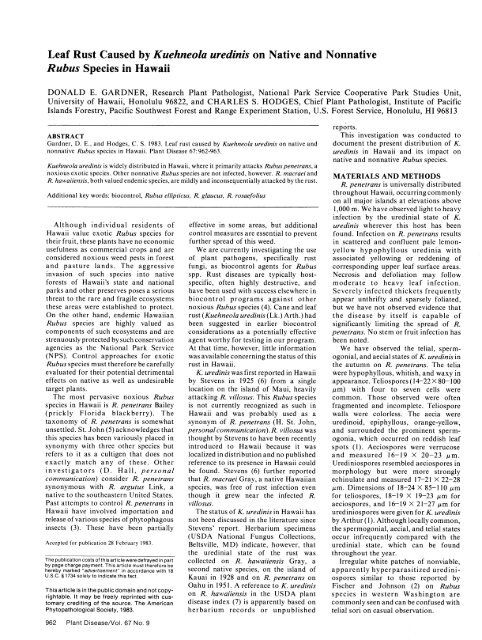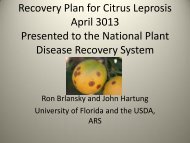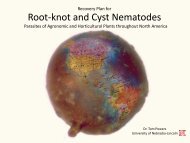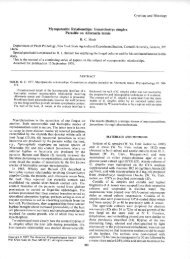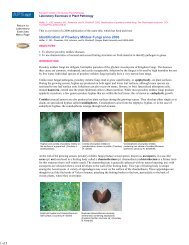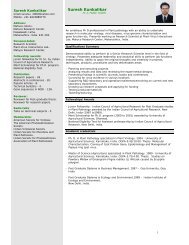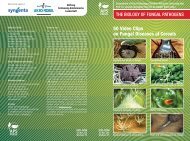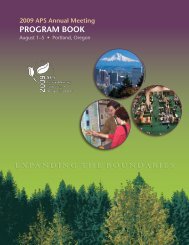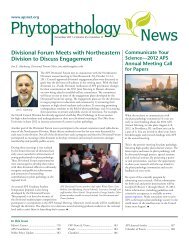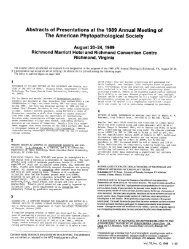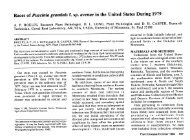Leaf Rust Caused by Kuehneola uredinis on Native and Nonnative ...
Leaf Rust Caused by Kuehneola uredinis on Native and Nonnative ...
Leaf Rust Caused by Kuehneola uredinis on Native and Nonnative ...
Create successful ePaper yourself
Turn your PDF publications into a flip-book with our unique Google optimized e-Paper software.
<str<strong>on</strong>g>Leaf</str<strong>on</strong>g> <str<strong>on</strong>g>Rust</str<strong>on</strong>g> <str<strong>on</strong>g>Caused</str<strong>on</strong>g> <str<strong>on</strong>g>by</str<strong>on</strong>g> <str<strong>on</strong>g>Kuehneola</str<strong>on</strong>g> <str<strong>on</strong>g>uredinis</str<strong>on</strong>g> <strong>on</strong> <strong>Native</strong> <strong>and</strong> N<strong>on</strong>native<br />
Rubus Species in Hawaii<br />
DONALD E. GARDNER, Research Plant Pathologist, Nati<strong>on</strong>al Park Service Cooperative Park Studies Unit,<br />
University of Hawaii, H<strong>on</strong>olulu 96822, <strong>and</strong> CHARLES S. HODGES, Chief Plant Pathologist, Institute of Pacific<br />
Isl<strong>and</strong>s Forestry, Pacific Southwest Forest <strong>and</strong> Range Experiment Stati<strong>on</strong>, U.S. Forest Service, H<strong>on</strong>olulu, HI 96813<br />
reports.<br />
ABSTRACT This investigati<strong>on</strong> was c<strong>on</strong>ducted to<br />
Gardner, D. E., <strong>and</strong> Hodges, C. S. 1983. <str<strong>on</strong>g>Leaf</str<strong>on</strong>g> rust caused <str<strong>on</strong>g>by</str<strong>on</strong>g> <str<strong>on</strong>g>Kuehneola</str<strong>on</strong>g> <str<strong>on</strong>g>uredinis</str<strong>on</strong>g> <strong>on</strong> native <strong>and</strong> document the present distributi<strong>on</strong> of K.<br />
n<strong>on</strong>native Rubus species in Hawaii. Plant Disease 67:962-963. <str<strong>on</strong>g>uredinis</str<strong>on</strong>g> in Hawaii <strong>and</strong> its impact <strong>on</strong><br />
native <strong>and</strong> n<strong>on</strong>native Rubus species.<br />
<str<strong>on</strong>g>Kuehneola</str<strong>on</strong>g> <str<strong>on</strong>g>uredinis</str<strong>on</strong>g> is widely distributed in Hawaii, where it primarily attacks Rubuspenetrans, a<br />
noxious exotic species. Other n<strong>on</strong>native Rubus species are not infected, however. R. macraei <strong>and</strong> MATERIALS AND METHODS<br />
R. hawaiiensis, both valued endemic species, are mildly <strong>and</strong> inc<strong>on</strong>sequentially attacked <str<strong>on</strong>g>by</str<strong>on</strong>g> the rust. R. penetrans is universally distri<br />
Additi<strong>on</strong>al key words: bioc<strong>on</strong>trol, Rubus ellipticus, R. glaucus, R. rosaefolius throughout Hawaii, occurring comm<strong>on</strong>ly<br />
<strong>on</strong> all major isl<strong>and</strong>s at elevati<strong>on</strong>s above<br />
1,000 m. We have observed light to heavy<br />
infecti<strong>on</strong> <str<strong>on</strong>g>by</str<strong>on</strong>g> the uredinial state of K.<br />
Although individual residents of effective in some areas, but additi<strong>on</strong>al <str<strong>on</strong>g>uredinis</str<strong>on</strong>g> wherever this host has been<br />
Hawaii value exotic Rubus species for c<strong>on</strong>trol measures are essential to prevent found. Infecti<strong>on</strong> <strong>on</strong> R. penetrans results<br />
their fruit, these plants have no ec<strong>on</strong>omic further spread of this weed. in scattered <strong>and</strong> c<strong>on</strong>fluent pale lem<strong>on</strong>usefulness<br />
as commercial crops <strong>and</strong> are We are currently investigating the use yellow hypophyllous uredinia with<br />
c<strong>on</strong>sidered noxious weed pests in forest of plant pathogens, specifically rust associated yellowing or reddening of<br />
<strong>and</strong> pasture l<strong>and</strong>s. The aggressive fungi, as bioc<strong>on</strong>trol agents for Rubus corresp<strong>on</strong>ding upper leaf surface areas.<br />
invasi<strong>on</strong> of such species into native spp. <str<strong>on</strong>g>Rust</str<strong>on</strong>g> diseases are typically host- Necrosis <strong>and</strong> defoliati<strong>on</strong> may follow<br />
forests of Hawaii's state <strong>and</strong> nati<strong>on</strong>al specific, often highly destructive, <strong>and</strong> moderate to heavy leaf infecti<strong>on</strong>.<br />
parks <strong>and</strong> other preserves poses a serious have been used with success elsewhere in Severely infected thickets frequently<br />
threat to the rare <strong>and</strong> fragile ecosystems bioc<strong>on</strong>trol programs against other appear unthrifty <strong>and</strong> sparsely foliated,<br />
these areas were established to protect. noxious Rubus species (4). Cane <strong>and</strong> leaf but we have not observed evidence that<br />
On the other h<strong>and</strong>, endemic Hawaiian rust(<str<strong>on</strong>g>Kuehneola</str<strong>on</strong>g><str<strong>on</strong>g>uredinis</str<strong>on</strong>g>(Lk.)Arth.)had the disease <str<strong>on</strong>g>by</str<strong>on</strong>g> itself is capable of<br />
Rubus species are highly valued as been suggested in earlier bioc<strong>on</strong>trol significantly limiting the spread of R.<br />
comp<strong>on</strong>ents of such ecosystems <strong>and</strong> are c<strong>on</strong>siderati<strong>on</strong>s as a potentially effective penetrans. No stem or fruit infecti<strong>on</strong> has<br />
strenuously protected <str<strong>on</strong>g>by</str<strong>on</strong>g> such c<strong>on</strong>servati<strong>on</strong> agent worthy for testing in our program. been noted.<br />
agencies as the Nati<strong>on</strong>al Park Service At that time, however, little informati<strong>on</strong> We have observed the telial, sperm-<br />
(NPS). C<strong>on</strong>trol approaches for exotic was available c<strong>on</strong>cerning the status of this og<strong>on</strong>ial, <strong>and</strong> aecial states of K. <str<strong>on</strong>g>uredinis</str<strong>on</strong>g> in<br />
Rubus species must therefore be carefully rust in Hawaii. the autumn <strong>on</strong> R. penetrans. The telia<br />
evaluated for their potential detrimental K. <str<strong>on</strong>g>uredinis</str<strong>on</strong>g> was first reported in Hawaii were hypophyllous, whitish, <strong>and</strong> waxy in<br />
effects <strong>on</strong> native as well as undesirable <str<strong>on</strong>g>by</str<strong>on</strong>g> Stevens in 1925 (6) from a single appearance. Teliospores(14-22X80-100<br />
target plants. locati<strong>on</strong> <strong>on</strong> the isl<strong>and</strong> of Maui, heavily gim) with four to seven cells were<br />
The most pervasive noxious Rubus attacking R. villosus. This Rubus species comm<strong>on</strong>. Those observed were often<br />
species in Hawaii is R. penetrans Bailey is not currently recognized as such in fragmented <strong>and</strong> incomplete. Teliospore<br />
(prickly Florida blackberry). The Hawaii <strong>and</strong> was probably used as a walls were colorless. The aecia were<br />
tax<strong>on</strong>omy of R. penetrans is somewhat syn<strong>on</strong>ym of R. penetrans (H. St. John, uredinoid, epiphyllous, orange-yellow,<br />
unsettled. St. John (5) acknowledges that pers<strong>on</strong>al communicati<strong>on</strong>).R. villosus was <strong>and</strong> surrounded the prominent spermthis<br />
species has been variously placed in thought <str<strong>on</strong>g>by</str<strong>on</strong>g> Stevens to have been recently og<strong>on</strong>ia, which occurred <strong>on</strong> reddish leaf<br />
syn<strong>on</strong>ymy with three other species but introduced to Hawaii because it was spots (1). Aeciospores were verrucose<br />
refers to it as a cultigen that does not localized in distributi<strong>on</strong> <strong>and</strong> no published <strong>and</strong> measured 16-19 X 20-23 #.m.<br />
exactly match any of these. Other reference to its presence in Hawaii could Urediniospores resembled aeciospores in<br />
investigators (D. Hall, pers<strong>on</strong>al be found. Stevens (6) further reported morphology but were more str<strong>on</strong>gly<br />
communicati<strong>on</strong>) c<strong>on</strong>sider R. penetrans that R. macraei Gray, a native Hawaiian echinulate <strong>and</strong> measured 17-21 X 22-28<br />
syn<strong>on</strong>ymous with R. argutus Link, a species, was free of rust infecti<strong>on</strong> even rem. Dimensi<strong>on</strong>s of 18-24 X 85-110 gm<br />
native to the southeastern United States. though it grew near the infected R. for teliospores, 18-19 X 19-23 #im for<br />
Past attempts to c<strong>on</strong>trol R. penetrans in villosus. aeciospores, <strong>and</strong> 16-19 X 21-27/.m for<br />
Hawaii have involved importati<strong>on</strong> <strong>and</strong> The status of K. <str<strong>on</strong>g>uredinis</str<strong>on</strong>g> in Hawaii has urediniospores were given for K. <str<strong>on</strong>g>uredinis</str<strong>on</strong>g><br />
release of various species of phytophagous not been discussed in the literature since <str<strong>on</strong>g>by</str<strong>on</strong>g> Arthur (1). Although locally comm<strong>on</strong>,<br />
insects (3). These have been partially Stevens' report. Herbarium specimens the spermog<strong>on</strong>ial, aecial, <strong>and</strong> telial states<br />
(USDA Nati<strong>on</strong>al Fungus Collecti<strong>on</strong>s, occur infrequently compared with the<br />
Accepted for publicati<strong>on</strong> 28 February 1983. Beltsville, MD) indicate, however, that uredinial state, which can be found<br />
_________________________ the uredinial state of the rust was throughout the year.<br />
The publicati<strong>on</strong> costs of this article were defrayed in part collected <strong>on</strong> R. hawaiiensis Gray, a Irregular white patches of n<strong>on</strong>viable,<br />
<str<strong>on</strong>g>by</str<strong>on</strong>g> page charge payment. This article must theretore be<br />
here<str<strong>on</strong>g>by</str<strong>on</strong>g> marked "advertisement" in accordance with 18 sec<strong>on</strong>d native species, <strong>on</strong> the isl<strong>and</strong> of apparently hyperparasitized uredini-<br />
U.S.C. §1734 solely to indicate this fact. Kauai in 1928 <strong>and</strong> <strong>on</strong> R. penetrans <strong>on</strong> ospores similar to those reported <str<strong>on</strong>g>by</str<strong>on</strong>g><br />
Oahu in 1951. A reference to K. <str<strong>on</strong>g>uredinis</str<strong>on</strong>g> Fischer <strong>and</strong> Johns<strong>on</strong> (2) <strong>on</strong> Rubus<br />
This article is inthe public domain <strong>and</strong> not copy- <strong>on</strong> R. hawaiiensis in the USDA plant species in western Washingt<strong>on</strong> are<br />
rightable. It may be freely reprinted with customary<br />
crediting of the source. The American disease index (7) is apparently based <strong>on</strong> comm<strong>on</strong>ly seen <strong>and</strong> can be c<strong>on</strong>fused with<br />
Phytopathological Society, 1983. herbarium records or unpublished telial sori <strong>on</strong> casual observati<strong>on</strong>.<br />
962 Plant Disease/Vol. 67 No. 9
Table 1. Infectivity of <str<strong>on</strong>g>Kuehneola</str<strong>on</strong>g> <str<strong>on</strong>g>uredinis</str<strong>on</strong>g> <strong>on</strong> native <strong>and</strong> noxious exotic Rubus species in Hawaii in the greenhouse (Table 1). We c<strong>on</strong>sider<br />
Species<br />
Seives<br />
infecti<strong>on</strong>'<br />
Field<br />
i<str<strong>on</strong>g>uredinis</str<strong>on</strong>g>,<br />
Greenhouse<br />
infecti<strong>on</strong> b<br />
Detached leaf<br />
infecti<strong>on</strong>c<br />
it likely that both native Rubus species<br />
are <strong>on</strong>ly slightly susceptible to K.<br />
with infectivity determined <str<strong>on</strong>g>by</str<strong>on</strong>g><br />
<strong>Native</strong><br />
R. hawaiiensis<br />
N<strong>on</strong>native<br />
+(l)d _(1)<br />
subtle factors of the envir<strong>on</strong>ment or of<br />
host or pathogen physiology. Thus, it is<br />
probable that R. macraei may also be<br />
R. ellipticus<br />
R. glaucus -<br />
R. penetrans +f + +<br />
R. rosaefolius - -<br />
aNatural infecti<strong>on</strong> observed <strong>on</strong> the isl<strong>and</strong>s of Hawaii, Maui, <strong>and</strong> Kauai.<br />
bPlants were inoculated <str<strong>on</strong>g>by</str<strong>on</strong>g> spraying with aqueous urediniospore suspensi<strong>on</strong>s of approximately 4 X<br />
attacked in the field under suitable<br />
c<strong>on</strong>diti<strong>on</strong>s.<br />
Aside from R. penetrans, our inoculati<strong>on</strong>s<br />
produced no infecti<strong>on</strong> <strong>on</strong> any of the<br />
other n<strong>on</strong>native species tested. These<br />
results are c<strong>on</strong>sistent with our field<br />
10' spores per milliliter to presaturati<strong>on</strong> <strong>and</strong> maintained under high (90-100%) relative humidity.<br />
Results were observed after about 3 wk.<br />
cLeaves were inoculated as in the greenhouse <strong>and</strong> maintained in moist petri dishes at room<br />
temperature or incubated at 17-19 C. Results were observed after about 3 wk.<br />
d+(l) Indicates light leaf infecti<strong>on</strong>s (ie, <strong>on</strong>e to several 1.0-mm-diameter discrete uredinial sori<br />
without epiphyllous symptoms).<br />
Indicates no infecti<strong>on</strong>.<br />
observati<strong>on</strong>s of these plants (Table 1).<br />
Our observati<strong>on</strong>s indicate that although<br />
K. <str<strong>on</strong>g>uredinis</str<strong>on</strong>g> exerts some impact <strong>on</strong> R.<br />
penetrans, the rust is not capable of<br />
severely curtailing this host in Hawaii<br />
under normal c<strong>on</strong>diti<strong>on</strong>s. The pathogen,<br />
however, has become well established <strong>on</strong><br />
+ Indicates a range of infecti<strong>on</strong> severity including heavy infecti<strong>on</strong> (ie, extensive col<strong>on</strong>izati<strong>on</strong> of leaf<br />
undersurfaces <str<strong>on</strong>g>by</str<strong>on</strong>g> c<strong>on</strong>vergent uredinia <strong>and</strong> corresp<strong>on</strong>ding epiphyllous symptoms).<br />
R. penetrans <strong>and</strong> is distributed throughout<br />
the Rh pnrans isl<strong>and</strong>s. It may <strong>and</strong> act diti is in c<strong>on</strong>juncti<strong>on</strong> uted th with<br />
R. hawaiiensis, the more comm<strong>on</strong> of<br />
the two native species, is also attacked <str<strong>on</strong>g>by</str<strong>on</strong>g><br />
K. <str<strong>on</strong>g>uredinis</str<strong>on</strong>g> in the field, although to a<br />
significantly lesser extent than is R.<br />
penetrans. Infecti<strong>on</strong> of R. hawaiiensis<br />
results <strong>on</strong>ly in <strong>on</strong>e to several small (1 mm<br />
diam.) individual, hypophyllous uredinial<br />
sori per leaf that remain discrete. Aside<br />
from the uredinia themselves, no<br />
symptoms or other detrimental results of<br />
infecti<strong>on</strong> are manifest <strong>on</strong> R. hawaiiensis.<br />
In agreement with Stevens' report (6), we<br />
have not observed K. <str<strong>on</strong>g>uredinis</str<strong>on</strong>g> <strong>on</strong> R.<br />
macraei in the field. This species is rare,<br />
however, <strong>and</strong> <strong>on</strong>ly infrequently encountered.<br />
Likewise, we have observed no<br />
infecti<strong>on</strong> <strong>on</strong> R. ellipticus Sm. (yellow<br />
Himalayan raspberry), R. rosaefolius<br />
Sm. (roseleaf raspberry), or R. glaucus<br />
Benth. (wild raspberry) in Hawaii, even in<br />
areas where infecti<strong>on</strong> <strong>on</strong> near<str<strong>on</strong>g>by</str<strong>on</strong>g> R.<br />
penetrans plants is heavy. We have found<br />
no c<strong>on</strong>clusive published report of K.<br />
<str<strong>on</strong>g>uredinis</str<strong>on</strong>g> attacking any of these three<br />
Rubus species elsewhere, although R.<br />
ellipticus <strong>and</strong> R. rosaefolius are implied<br />
as hosts of this rust in the USDA plant<br />
disease index (7). Like R. penetrans, these<br />
are secis ndeirale ocuring xotc<br />
are secis ndeirale ocuring xotc<br />
within or near Hawaii's NPS <strong>and</strong> other<br />
natural areas.<br />
To assess the infectivity of K. <str<strong>on</strong>g>uredinis</str<strong>on</strong>g><br />
<strong>on</strong> each of the menti<strong>on</strong>ed native <strong>and</strong><br />
n<strong>on</strong>native Rubus species under uniform<br />
c<strong>on</strong>diti<strong>on</strong>s, rooted cuttings of each<br />
species were established in pots in the<br />
greenhouse <strong>on</strong> a mist bench or were<br />
covered with plastic bags for 48 hr after<br />
X 10 spores per milliliter. Inoculum was<br />
collected from various R. penetransinfested<br />
sites <strong>on</strong> the isl<strong>and</strong>s of Hawaii <strong>and</strong><br />
Maui. Detached leaves of each species<br />
were also tested <str<strong>on</strong>g>by</str<strong>on</strong>g> placing leaves of<br />
comparable age <strong>and</strong> developmental state<br />
in moist petri dishes <strong>and</strong> spraying them<br />
with spore suspensi<strong>on</strong>s of similar<br />
c<strong>on</strong>centrati<strong>on</strong>s. The leaves were maintained<br />
at room temperature in the<br />
laboratory or at 17-19 C in a lighted<br />
incubator,<br />
RESULTS AND DISCUSSION<br />
R. penetrans became readily infected<br />
under greenhouse c<strong>on</strong>diti<strong>on</strong>s, with<br />
uredinia developing about 3 wk after<br />
inoculati<strong>on</strong>. Exp<strong>and</strong>ing or mature leaves<br />
appeared most susceptible, whereas<br />
newly formed unexp<strong>and</strong>ed leaves were<br />
not infected. The disease was perpetuated<br />
in the greenhouse <strong>on</strong>ly under c<strong>on</strong>diti<strong>on</strong>s<br />
of high humidity. As in the field, infecti<strong>on</strong><br />
was limited to undersurfaces of the leaves<br />
<strong>and</strong> yellowing, reddening, <strong>and</strong> necrosis<br />
occurred <strong>on</strong> corresp<strong>on</strong>ding upper areas.<br />
No stem or fruit infecti<strong>on</strong> occurred in the<br />
greenhouse. Detached leaves of this<br />
species also became infected (Table 1),<br />
withureini liewie apeaingabot 3<br />
withureini liewie apeaingabot 3<br />
wk after inoculati<strong>on</strong>. Light <strong>and</strong> temperature<br />
c<strong>on</strong>diti<strong>on</strong>s of incubati<strong>on</strong> did not<br />
appear critical to this development,<br />
R. macraei became lightly infected in<br />
the greenhouse even though natural<br />
infecti<strong>on</strong> in the field had not been found<br />
in our limited observati<strong>on</strong>. Individual,<br />
scattered uredinial s<strong>on</strong>iwere produced <strong>on</strong><br />
several leaves without apparent negative<br />
other purposely introduced bioc<strong>on</strong>trol<br />
agents in impairing the growth <strong>and</strong> vigor<br />
of this species. The aggressiveness <strong>and</strong><br />
competitive advantage of R. penetrans in<br />
favor of native plants may there<str<strong>on</strong>g>by</str<strong>on</strong>g> be<br />
lessened. Although the two endemic<br />
Rubus species show some susceptibility<br />
to K. <str<strong>on</strong>g>uredinis</str<strong>on</strong>g>, the minimal effect <strong>on</strong> these<br />
species indicates a genetic differential<br />
between these <strong>and</strong> R. penetrans that is<br />
regarded positively. The possibility that<br />
various races of K. <str<strong>on</strong>g>uredinis</str<strong>on</strong>g>, such as those<br />
known am<strong>on</strong>g other rusts, exist in Hawaii<br />
was not c<strong>on</strong>sidered in this study.<br />
Attenti<strong>on</strong> may be directed toward the<br />
determinati<strong>on</strong> of such races if future<br />
observati<strong>on</strong>s indicate that they occur.<br />
Further work toward the bioc<strong>on</strong>trol of<br />
undesirable Rubus species in Hawaii with<br />
other rusts, introduced for this purpose,<br />
is planned for the future.<br />
ACKNOWLEDGMENTS<br />
We thank Clifford Smith for his c<strong>on</strong>tributi<strong>on</strong><br />
to this project. We also acknowledge the technical<br />
assistance of D ea Kageler <strong>and</strong> Calen Miyahara.<br />
LITERATURE CITED<br />
States <strong>and</strong> Canada. Purdue Research Foundati<strong>on</strong>.<br />
West Lafayette, IN. 438 pp.<br />
2. Fischer, 0. W., <strong>and</strong> Johns<strong>on</strong>. F. 1950. Cane <strong>and</strong><br />
leaf rust, <str<strong>on</strong>g>Kuehneola</str<strong>on</strong>g> uredini~s (link) Arth.. of<br />
blackberries in western Washingt<strong>on</strong>. Phyto-<br />
pathology 40:199-204.<br />
3. Gardner, D. E., <strong>and</strong> Davis, C. J. 1982. The<br />
prospects for biological c<strong>on</strong>trol of n<strong>on</strong>native<br />
plants in Hawaiian nati<strong>on</strong>al parks. Nat. Park<br />
Serv., CPSU/ Univ. Hawaii Tech. Rep. 45. 55 pp.<br />
4. Hasan, 5. 1980. Plant pathogens <strong>and</strong> biological<br />
c<strong>on</strong>trol of weeds. Rev. Plant Pathol. 59:349-356.<br />
5. St. John, H. 1973. List <strong>and</strong> Summary of the<br />
Flowering Plants in the Hawaiian Isl<strong>and</strong>s. Mem.<br />
1. Pacific Tropical Botanical Garden, tLawai, HI.<br />
519 pp.<br />
inoculati<strong>on</strong> to ensure high (90-100%) impact <strong>on</strong> the plants. Detached leaves of<br />
relative humidity. The plants were R. macraei did not become infected.<br />
spraed o pesaurai<strong>on</strong>wit frshl C<strong>on</strong>erslydetche levesof .<br />
spraed wih t prsatuatin feshl C<strong>on</strong>ersly, etahed eavsofR.<br />
collected urediniospores in water hawaiiensis became lightly infected but<br />
suspensi<strong>on</strong>s at c<strong>on</strong>centrati<strong>on</strong>s of about 4 no infecti<strong>on</strong> was obtained <strong>on</strong> this species<br />
~<br />
6. Stevens, F. L. 1925. Hawaiian Fungi. Bernice P.<br />
Bishop Museum Bull. 19. Bishop Museum,<br />
H<strong>on</strong>olulu. 189 pp.<br />
U. us. Department of Agriculture. 1960. index of<br />
Plant Diseases in the United States. Agric.<br />
H<strong>and</strong>bk. 165. 531 pp.<br />
Plant Disease/September 1983 963


